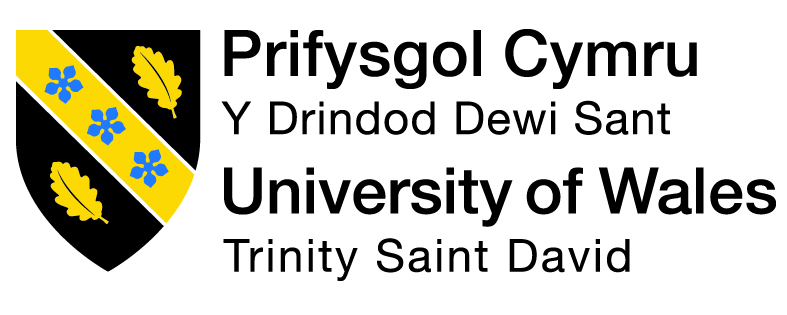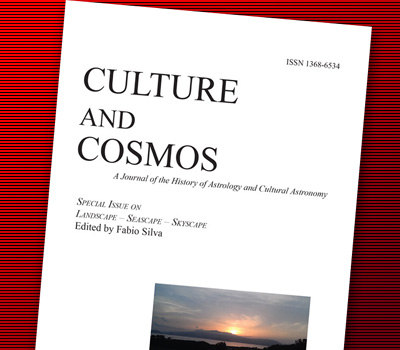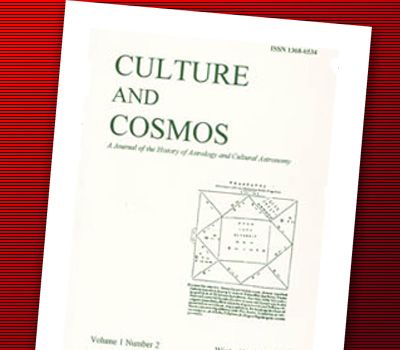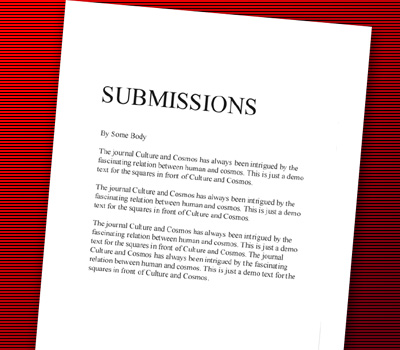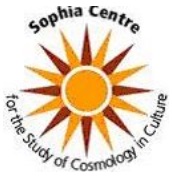We are currently seeking submissions for future volumes of Culture and Cosmos.
Volume 1, No. 2
Books Noticed
Cosmic Influences on Humans, Animals and Plants: An Annotated Bibliography, John T.Burns, Magill Bibliographies, Scarecrow Press Inc, Lanham, Md., and London, Salem Press, Pasadena, CA and Englewood Cliffs, NJ, 1997, 203 pp., £32.80.
This volume by John Burns, Professor of Biology at Bethany College, West Virginia, joins the author’s other bibliography, Cycles in Humans and Nature as an invaluable starting point for research into recent work on the question of celestial-terrestrial influences and correlations. The four sections include material on the influence of sunspots, the solar wind and auroras, lunar and tidal influences, planetary influences and possible mechanisms for cosmic influences. Burns covers much material that would otherwise escape the casual researcher, such as the article on the breeding of the sooty tern published in The Auk in 1959 or Nick Kollerstrom’s paper on ‘The Diurnal Cycle and Chemical Reaction Rate’, published in Exact, Natural and Human Sciences in the Presence of Uncontrolled Environment Factors by the University Library of Brussels in 1992. Attention is given to prominent figures such as John Dewey, Michel Gauquelin and Rudolf Steiner and equal prominence given to different perspectives. This is a superb source document for any researcher concerned with twentieth century attempts to demonstrate cosmic influences, some of it necessary reading for all concerned with the wider ramifications of modern cosmology.
The Scientific Invention of Hieroglyphics or Hurrah for Pliny!, Rosalind Park, Azoth Publications, 1997, ISBN 0 9532056 0 6, 39 pp., for further information contact The British Museum Bookshop, 36 Great Russell Street, London WC1B 3PP.
The challenge to the concept that the Greeks possessed a unique genius which gave birth to western rationalism and science is proceeding in a number of quarters, inspired notably by Martin Bernal’s Black Athena. In this provocative and persuasive pamphlet Rosalind Park presents initial arguments for the antecedents of Greek science and astronomy in Egypt. She challenges the notion, itself ascribed to the Greeks, that Egyptian hieroglyphs represented a solidly symbolic and mythical cosmology and argues instead that they can be read as a precise technical language revealing an astronomy as precise as that found in Greece. Her final proof is a visual one, a comparison of Greek spherical geometry (after D.R. Dicks, 1970) and a 19th dynasty illustration of an astronomer measuring the equinoxes.
The Man in the Moone, Francis Godwin, with a modern introduction, Logaston Press, Little Logaston, Woonton, Almeley, Herefordshire HR3 6QH, UK, ISBN 1 873827 64 4, 41 pp., £8.95.
Written by Francis Godwin, Bishop of Hereford from 1617 to 1633, The Man in the Moone tells the story of Domingo Gonsales, who made a voyage to the moon in a ship powered by large birds, each attached to a pulley. It’s a charming tale which fits into several literary traditions - of celestial journeys, voyages of discovery and science fiction (see Alan Weber’s paper on ‘Changes in Celestial Journey Literature, 1400 - 1650’. Culture and Cosmos Vol. 1, no 1). This edition includes an excellent and informative introduction examining both influences on Godwin (the astronomical revolution and European voyages of exploration) and his influence on others (Jonathan Swift and Gulliver’s Travels). The introduction concludes with the intriguing thought that Godwin may have had a political agenda: ‘It was during this time that the Dutch seized Formosa and trade with the East was increasing...perhaps Godwin was calling for greater English enterprise in the direction of China’.
The Abbreviation of the Introduction to Astrology, Abu Ma’shar, edited and translated by Charles Burnet, with technical and historical annotations by Charles Burnett, Graeme Tobyn, Geoffrey Cornelius and Vernon Wells, Arhat Publications, 350 Underpass Road, Box 1750, Brewster, MA 02631, USA, 58 pp., $9.50.
Abu Ma’shar (787-886) acquired immense renown in his lifetime as the leading astrologer in the Islamic world, a reputation maintained in medieval Europe where he was known as Albumasar. He appears to have begun his career under the caliphate of al-Mamun (813-833) as an expert in hadith, the sayings of Mohammed, but in 825 he realised that to understand philosophical arguments he should study mathematics in all its forms, including astrology. He was thus a crucial figure in the Islamic world’s rediscovery of Indian, Iranian and Hellenistic astrology, and hence of its later transmission to Catholic Europe. This text is a revision of that published by Brill in 1994 (edited and translated by Charles Burnett with K. Yamamoto and M. Yano) with the Arabic and Latin texts and philological annotations replaced by astrological footnotes which are invaluable for placing Abu Ma’shar’s astrology in its context. As an insight into the practical, cultural application of astronomy in ninth century Islam, this work is invaluable.
History of Astronomy: An Encyclopaedia, edited John Lankford, Garland Publishing, New York and London, 1997, 594 pp. Cambridge Illustrated History of Astronomy, edited Michael Hoskin, Cambridge University Press, Cambridge, 1997, 392 pp.
Together with Garland publishing’s excellent Encyclopaedia of Cosmology (edited Norris Hetherington, 1993), these two volumes provide welcome reference material on the history of astronomy in all its forms. This is an increasingly necessary task in view of the rediscovery of ancient cosmologies and the rapid advances in modern astronomy and the publishers and editors of both deserve congratulations for their work. The Cambridge edition is aimed more at the general market while the Garland edition is more specialised, but both have their place. The Garland edition includes short articles on such matters as literature and astronomy but it is not always apparent where one should turn to for the relevant information. There is no listing under ‘Maya’ for example, and one would stumble by chance upon the entry for the Mayan observatory, the Caracol at Chichén Itza. There are also some curious omissions, such as Thales, who should surely deserve a mention. The Cambridge volume is arranged chronologically with nine chapters progressing from prehistory through to astrophysics and Big Bang cosmology. The early chapters deal adequately with the question of religious pressures on astronomy and motives for astronomical research. However, neither of these latest publications competes with the 1993 Encyclopedia in its coverage of astronomy and astrology in other cultures - in Mesopotamia or amongst native Americans, for instance.

